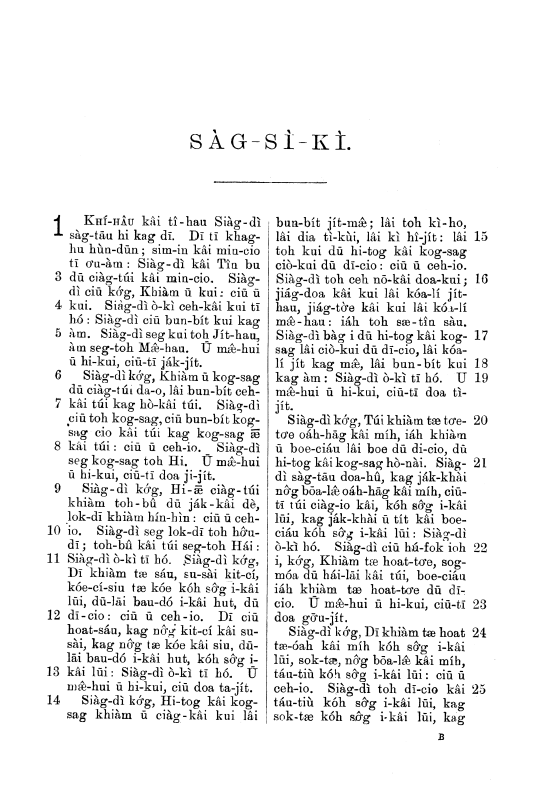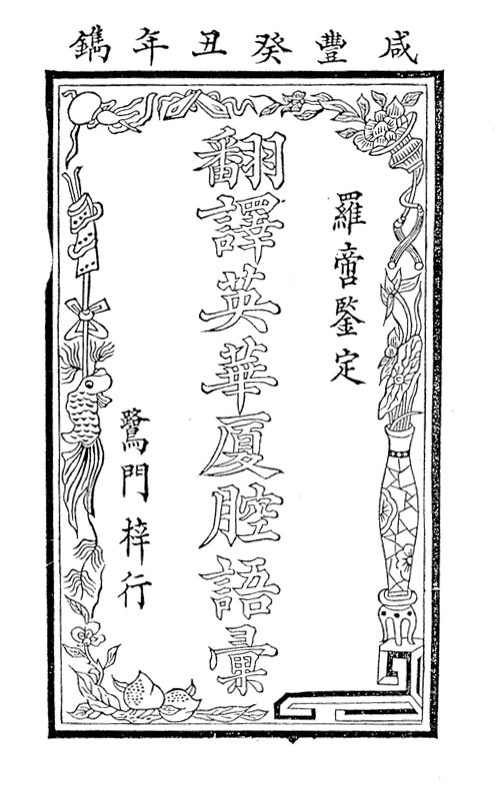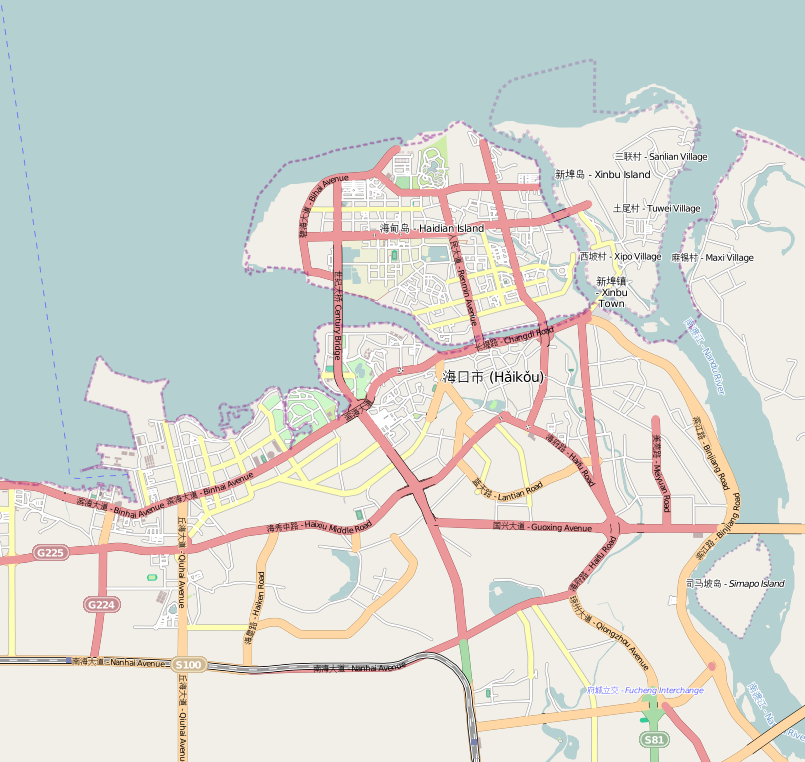|
Bǽh-oe-tu
''Bǽh-oe-tu'' (abbr. BOT; zh, t=白話字) is an orthography used to write the Haikou dialect of the Hainanese language. It was invented by Carl C. Jeremiassen, a Danish pioneer missionary in Fucheng (present-day Haikou) in 1881. Spelling schemes Consonants Vowels Tones Sample texts from Hainanese Bibles File:HainanBible1.gif File:HainaneseBible2.gif File:HainaneseBible3.gif File:HainaneseBible4.gif See also * Hainanese Transliteration Scheme The Hainanese Transliteration Scheme () is a romanization scheme developed by the Guangdong Provincial Education Department in September 1960 as one of four systems collectively referred to as Guangdong Romanization. The scheme describes the Wench ... ({{lang, zh-Hans-CN, 海南话拼音方案) External LinksGospel of Luke in Hainan Romanized (Bǽh-oe-tu) published in 1916. Hainan Min Latin-script orthographies Romanization of Chinese ... [...More Info...] [...Related Items...] OR: [Wikipedia] [Google] [Baidu] |
Hainan Min
Hainanese ( Hainan Romanised: ''Hái-nâm-oe'', Hainanese Pinyin: ''Hhai3 nam2 ue1'', ), also known as Qiongwen (), Qiongyu () or Hainan Min () is a group of Min Chinese varieties spoken in the far southern Chinese island province of Hainan and regional overseas Chinese communities such as in Singapore and Thailand. In the classification of Yuan Jiahua, it was included in the Southern Min group, being mutually unintelligible with other Southern Min varieties such as Hokkien– Taiwanese and Teochew. In the classification of Li Rong, used by the ''Language Atlas of China'', it was treated as a separate Min subgroup. Hou Jingyi combined it with Leizhou Min, spoken on the neighboring mainland Leizhou Peninsula, in a Qiong–Lei group. "Hainanese" is also used for the language of the Li people living in Hainan, but generally refers to Min varieties spoken in Hainan. Phonology The phonologies of the different varieties of Hainanese are highly divergent, with the Wenchang di ... [...More Info...] [...Related Items...] OR: [Wikipedia] [Google] [Baidu] |
Hainanese
Hainanese ( Hainan Romanised: ''Hái-nâm-oe'', Hainanese Pinyin: ''Hhai3 nam2 ue1'', ), also known as Qiongwen (), Qiongyu () or Hainan Min () is a group of Min Chinese varieties spoken in the far southern Chinese island province of Hainan and regional overseas Chinese communities such as in Singapore and Thailand. In the classification of Yuan Jiahua, it was included in the Southern Min group, being mutually unintelligible with other Southern Min varieties such as Hokkien– Taiwanese and Teochew. In the classification of Li Rong, used by the ''Language Atlas of China'', it was treated as a separate Min subgroup. Hou Jingyi combined it with Leizhou Min, spoken on the neighboring mainland Leizhou Peninsula, in a Qiong–Lei group. "Hainanese" is also used for the language of the Li people living in Hainan, but generally refers to Min varieties spoken in Hainan. Phonology The phonologies of the different varieties of Hainanese are highly divergent, with the Wench ... [...More Info...] [...Related Items...] OR: [Wikipedia] [Google] [Baidu] |
Pe̍h-ōe-jī
( ; , , ; POJ), also known as Church Romanization, is an orthography used to write variants of Hokkien Southern Min, particularly Taiwanese Hokkien, Taiwanese and Amoy dialect, Amoy Hokkien, and it is widely employed as one of the writing systems for Southern Min. During its peak, it had hundreds of thousands of readers. Developed by Western missionary, missionaries working among the Chinese emigration, Chinese diaspora in Southeast Asia in the 19th century and refined by missionaries working in Xiamen and Tainan, it uses a modified Latin alphabet and some diacritics to represent the spoken language. After initial success in Fujian, POJ became most widespread in Taiwan and, in the mid-20th century, there were over 100,000 people literate in POJ. A large amount of printed material, religious and secular, has been produced in the script, including Taiwan's first newspaper, the ''Taiwan Church News''. During Taiwan under Japanese rule, Japanese rule (1895–1945), the use of was ... [...More Info...] [...Related Items...] OR: [Wikipedia] [Google] [Baidu] |
Latin Alphabet
The Latin alphabet, also known as the Roman alphabet, is the collection of letters originally used by the Ancient Rome, ancient Romans to write the Latin language. Largely unaltered except several letters splitting—i.e. from , and from —additions such as , and extensions such as letters with diacritics, it forms the Latin script that is used to write most languages of modern Languages of Europe, Europe, languages of Africa, Africa, languages of the Americas, the Americas, and Languages of Oceania, Oceania. Its basic modern inventory is standardized as the ISO basic Latin alphabet. Etymology The term ''Latin alphabet'' may refer to either the alphabet used to write Latin (as described in this article) or other alphabets based on the Latin script, which is the basic set of letters common to the various alphabets descended from the classical Latin alphabet, such as the English alphabet. These Latin-script alphabets may discard letters, like the Rotokas alphabet, or add new ... [...More Info...] [...Related Items...] OR: [Wikipedia] [Google] [Baidu] |
Haikou Dialect ...
The Haikou dialect is a topolect of Chinese and a subvariety of Hainanese spoken in Haikou, the capital of the Hainan province and island of China. Phonology The Haikou dialect has the following initials: The finals are: There are also two syllabic nasals, /m̩/ and /ŋ̍/. The tone categories (described using Chao tone letters) are: See also * Hainan Romanized Notes References Sources * * {{st-lang-stub Hainan Min dialect A dialect is a Variety (linguistics), variety of language spoken by a particular group of people. This may include dominant and standard language, standardized varieties as well as Vernacular language, vernacular, unwritten, or non-standardize ... [...More Info...] [...Related Items...] OR: [Wikipedia] [Google] [Baidu] |
Carl C
Carl may refer to: *Carl, Georgia, city in USA *Carl, West Virginia, an unincorporated community *Carl (name), includes info about the name, variations of the name, and a list of people with the name *Carl², a TV series * "Carl", an episode of television series ''Aqua Teen Hunger Force'' * An informal nickname for a student or alum of Carleton College CARL may refer to: *Canadian Association of Research Libraries *Colorado Alliance of Research Libraries See also *Carle (other) *Charles *Carle, a surname *Karl (other) *Karle (other) Karle may refer to: Places * Karle (Svitavy District), a municipality and village in the Czech Republic * Karli, India, a town in Maharashtra, India ** Karla Caves, a complex of Buddhist cave shrines * Karle, Belgaum, a settlement in Belgaum ... {{disambig ja:カール zh:卡尔 ... [...More Info...] [...Related Items...] OR: [Wikipedia] [Google] [Baidu] |
Book Of Genesis
The Book of Genesis (from Greek language, Greek ; ; ) is the first book of the Hebrew Bible and the Christian Old Testament. Its Hebrew name is the same as its incipit, first word, (In the beginning (phrase), 'In the beginning'). Genesis purports to be an account of the Genesis creation narrative, creation of the world, the early history of humanity, and the Jews#Origins, origins of the Jewish people. In Judaism, the theological importance of Genesis centers on the covenants linking God in Judaism, God to his chosen people and the people to the Promised Land. Genesis is part of the Torah or Pentateuch, the first five books of the Bible. Tradition credits Moses as the Torah's author. However, there is scholarly consensus that the Book of Genesis was composed several centuries later, after the Babylonian captivity, Babylonian Babylonian captivity, captivity, possibly in the fifth century BC. Based on the scientific interpretation of Archaeology, archaeological, Genetics, genetic, ... [...More Info...] [...Related Items...] OR: [Wikipedia] [Google] [Baidu] |
Abbr
An abbreviation () is a shortened form of a word or phrase, by any method including shortening, contraction, initialism (which includes acronym), or crasis. An abbreviation may be a shortened form of a word, usually ended with a trailing period. For example, the term ''etc.'' is the usual abbreviation for the Latin phrase . Types A '' contraction'' is an abbreviation formed by replacing letters with an apostrophe. Examples include ''I'm'' for ''I am'' and ''li'l'' for ''little''. An ''initialism'' or ''acronym'' is an abbreviation consisting of the initial letter of a sequence of words without other punctuation. For example, FBI ( ), USA ( ), IBM ( ), BBC ( ). When initialism is used as the preferred term, acronym refers more specifically to when the abbreviation is pronounced as a word rather than as separate letters; examples include SWAT and NASA. Initialisms, contractions and crasis share some semantic and phonetic functions, and are connected by the term ''abbreviation' ... [...More Info...] [...Related Items...] OR: [Wikipedia] [Google] [Baidu] |
Danish People
Danes (, ), or Danish people, are an ethnic group and nationality native to Denmark and a modern nation identified with the country of Denmark. This connection may be ancestral, legal, historical, or cultural. History Early history Denmark has been inhabited by various Germanic peoples since ancient times, including the Angles (tribe), Angles, Cimbri, Jutes, Herules, Teutones and others. A 2025 study in ''Nature'' found genetic evidence of an influx of central European population after about 500 ce into the region later ruled by the Danes. Viking Age The first mention of Danes within Denmark is on the Jelling stones#Runestone of Harald Bluetooth, Jelling Rune Stone, which mentions the conversion of the Danes to Christianity by Harald Bluetooth in the 10th century. Between and the early 980s, Bluetooth established a kingdom in the lands of the Danes, stretching from Jutland to Scania. Around the same time, he received a visit from a German missionary who, by surviving an t ... [...More Info...] [...Related Items...] OR: [Wikipedia] [Google] [Baidu] |
Haikou
Haikou; Chinese postal romanization, formerly romanized as Hoihow is the capital city, capital and most populous city of the Chinese province of Hainan. Haikou city is situated on the northern coast of Hainan, by the mouth of the Nandu River. The northern part of the city is on the Haidian Island, which is separated from the main part of Haikou by the Haidian River, a branch of the Nandu. Administratively, Haikou is a prefecture-level city, comprising four districts, and covering . There are 2,046,189 inhabitants in the built-up area, all living within the four urban districts of the city. Haikou was originally a port city, serving as the port for Qiongshan District, Qiongshan. During the Chinese Civil War, Haikou was one of the last Republic of China (1912–1949), Nationalist strongholds to be taken by the Communist Party of China, Communists – with the Battle of Hainan Island in 1950. Currently, more than half of the island's total trade still goes through Haikou's ports. ... [...More Info...] [...Related Items...] OR: [Wikipedia] [Google] [Baidu] |
Hainanese Transliteration Scheme
The Hainanese Transliteration Scheme () is a romanization scheme developed by the Guangdong Provincial Education Department in September 1960 as one of four systems collectively referred to as Guangdong Romanization. The scheme describes the Wenchang dialect spoken in Wenchang, Hainan which is considered to be the prestige dialect of Hainanese. At the time of the scheme's creation, Hainan was part of Guangdong, until it was separated to form its own province in 1988. This system utilises the Latin alphabet with superscript numbers to represent tone. System Letters This system uses the Latin alphabet, excluding the letters , , , , , , , and . Initials Finals Tones See also *Guangdong romanization *Hainanese Hainanese ( Hainan Romanised: ''Hái-nâm-oe'', Hainanese Pinyin: ''Hhai3 nam2 ue1'', ), also known as Qiongwen (), Qiongyu () or Hainan Min () is a group of Min Chinese varieties spoken in the far southern Chinese island province of Hain ... References * ... [...More Info...] [...Related Items...] OR: [Wikipedia] [Google] [Baidu] |
Latin-script Orthographies
The Latin script, also known as the Roman script, is a writing system based on the letters of the classical Latin alphabet, derived from a form of the Greek alphabet which was in use in the ancient Greek city of Cumae in Magna Graecia. The Greek alphabet was altered by the Etruscans, and subsequently their alphabet was altered by the Ancient Romans. Several Latin-script alphabets exist, which differ in graphemes, collation and phonetic values from the classical Latin alphabet. The Latin script is the basis of the International Phonetic Alphabet (IPA), and the 26 most widespread letters are the letters contained in the ISO basic Latin alphabet, which are the same letters as the English alphabet. Latin script is the basis for the largest number of alphabets of any writing system and is the most widely adopted writing system in the world. Latin script is used as the standard method of writing the languages of Western and Central Europe, most of sub-Saharan Africa, the Americas, a ... [...More Info...] [...Related Items...] OR: [Wikipedia] [Google] [Baidu] |





